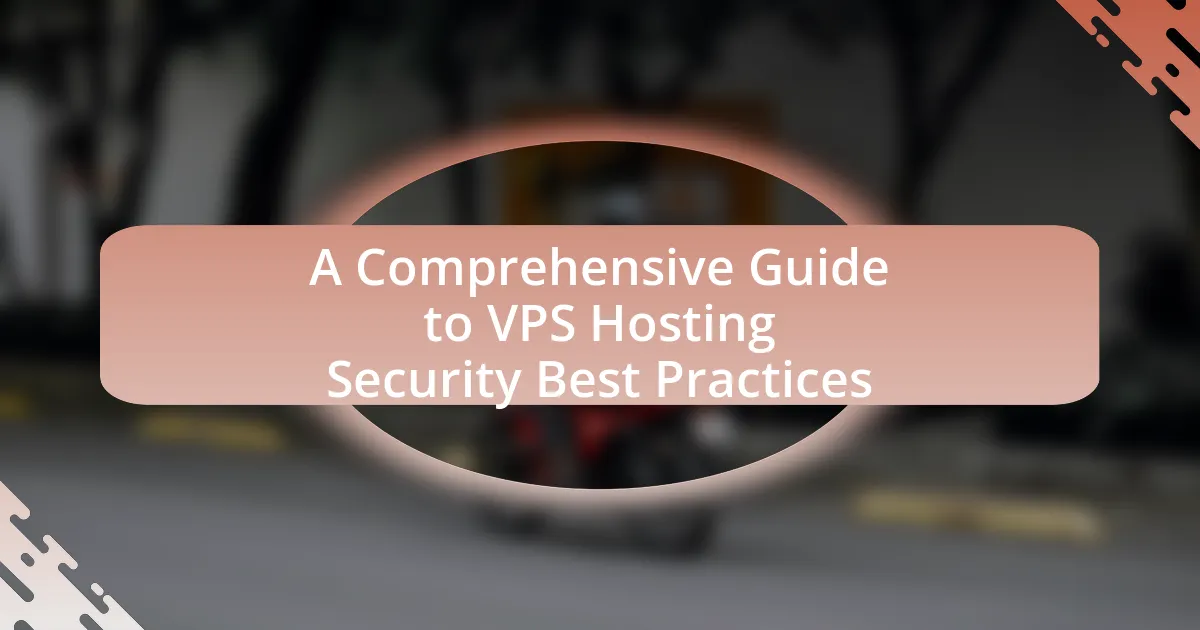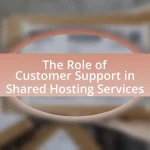VPS hosting security encompasses the measures and protocols designed to protect virtual private servers from unauthorized access and cyber threats. This article provides a comprehensive overview of VPS security, detailing how it differs from other hosting types, the unique vulnerabilities it faces, and the impact of virtualization on security. Key topics include the importance of robust security practices, potential risks of inadequate security, best practices for securing VPS environments, and common mistakes to avoid. Additionally, the article highlights effective tools and strategies for monitoring and enhancing VPS security, ensuring that users can safeguard their sensitive data and maintain the integrity of their server environments.
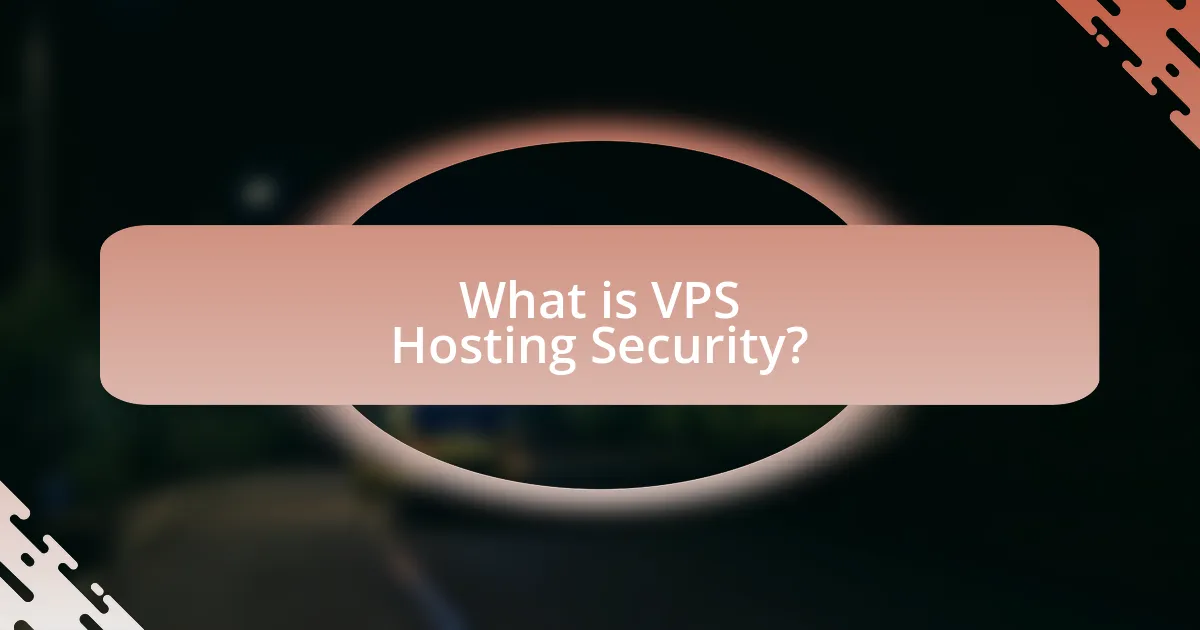
What is VPS Hosting Security?
VPS hosting security refers to the measures and protocols implemented to protect virtual private servers from unauthorized access, data breaches, and other cyber threats. These security measures include firewalls, intrusion detection systems, regular software updates, and secure access controls, which collectively safeguard the server environment. According to a report by Cybersecurity Ventures, cybercrime is projected to cost the world $10.5 trillion annually by 2025, highlighting the critical need for robust security in VPS hosting to mitigate risks and protect sensitive data.
How does VPS Hosting differ from other hosting types in terms of security?
VPS hosting offers enhanced security compared to shared hosting and dedicated hosting due to its isolated environment. In VPS hosting, each virtual server operates independently, meaning that security breaches on one VPS do not affect others on the same physical server. This isolation allows for customized security measures, such as firewalls and intrusion detection systems, tailored to the specific needs of the VPS user. In contrast, shared hosting users are vulnerable to attacks that can arise from other users on the same server, while dedicated hosting, although secure, may not provide the same level of resource allocation and management flexibility as VPS. The ability to implement specific security protocols and configurations in VPS hosting significantly reduces the risk of unauthorized access and data breaches.
What unique vulnerabilities does VPS Hosting face?
VPS hosting faces unique vulnerabilities primarily due to its shared resources among multiple virtual servers on a single physical machine. This resource sharing can lead to security risks such as data leakage, where one VPS can potentially access data from another if proper isolation measures are not implemented. Additionally, VPS environments are susceptible to attacks like Distributed Denial of Service (DDoS), which can overwhelm the shared resources and affect all virtual servers on the host. Furthermore, misconfigurations in the VPS setup can expose the server to unauthorized access, making it critical for users to maintain strict security protocols and regularly update their software to mitigate these vulnerabilities.
How does virtualization impact security in VPS Hosting?
Virtualization enhances security in VPS hosting by isolating virtual environments, which prevents unauthorized access between different VPS instances. This isolation means that if one VPS is compromised, the others remain unaffected, thereby containing potential security breaches. Additionally, virtualization allows for the implementation of security measures such as hypervisor-level firewalls and intrusion detection systems, which can monitor and protect multiple VPS instances simultaneously. According to a study by the National Institute of Standards and Technology (NIST), virtualization can improve security posture by enabling better resource allocation and management, ultimately leading to a more secure hosting environment.
Why is security crucial for VPS Hosting?
Security is crucial for VPS hosting because it protects sensitive data and ensures the integrity of the virtual server environment. VPS hosting often involves multiple users sharing the same physical server, which increases the risk of unauthorized access and data breaches. According to a report by Cybersecurity Ventures, cybercrime is projected to cost the world $10.5 trillion annually by 2025, highlighting the importance of robust security measures. Implementing firewalls, regular software updates, and strong authentication protocols can significantly mitigate these risks, safeguarding both the server and the data it hosts.
What are the potential risks of inadequate VPS security?
Inadequate VPS security can lead to significant risks, including data breaches, unauthorized access, and service disruptions. These vulnerabilities can expose sensitive information, such as personal data and financial records, to cybercriminals, resulting in identity theft or financial loss. Additionally, compromised VPS instances can be used to launch attacks on other systems, contributing to a broader security threat landscape. According to a report by Cybersecurity Ventures, cybercrime damages are projected to reach $10.5 trillion annually by 2025, highlighting the critical importance of robust security measures for VPS environments.
How can security breaches affect businesses using VPS Hosting?
Security breaches can severely impact businesses using VPS hosting by compromising sensitive data, leading to financial losses and reputational damage. When a VPS is breached, attackers can access confidential information such as customer data, payment details, and proprietary business information, which can result in identity theft or fraud. According to a report by IBM, the average cost of a data breach in 2023 is approximately $4.45 million, highlighting the financial implications for affected businesses. Additionally, the loss of customer trust can lead to decreased sales and long-term damage to a brand’s reputation, as 81% of consumers would stop doing business with a company after a data breach, according to a study by KPMG. Thus, security breaches in VPS hosting can have profound and lasting effects on a business’s financial health and market position.
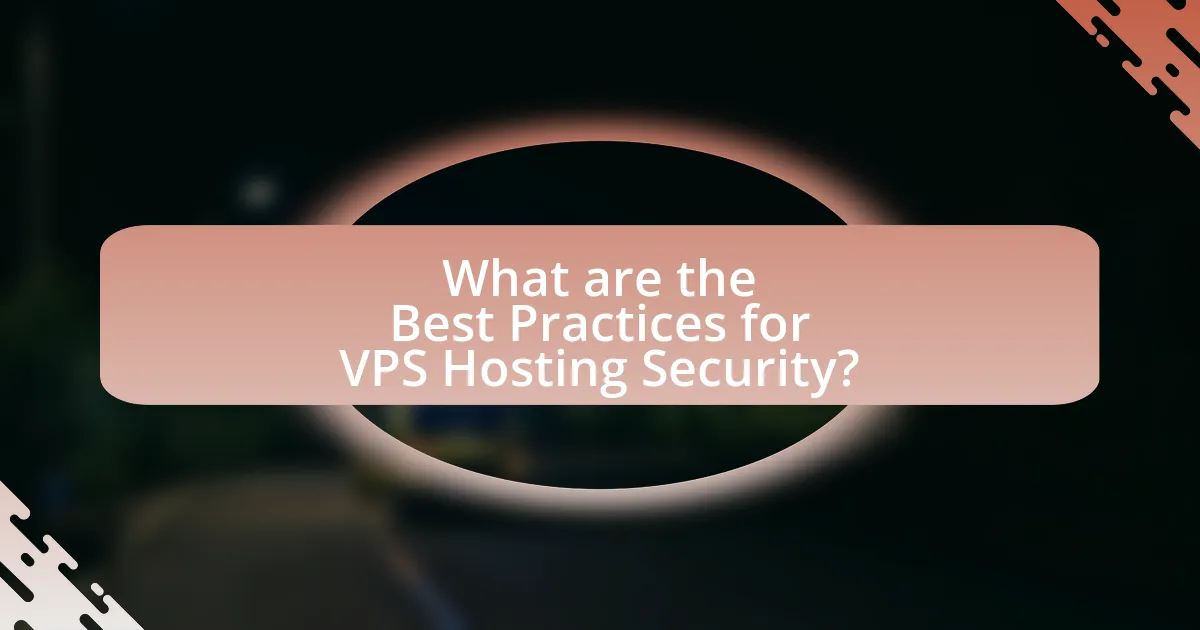
What are the Best Practices for VPS Hosting Security?
The best practices for VPS hosting security include implementing strong passwords, regularly updating software, using firewalls, and enabling two-factor authentication. Strong passwords reduce the risk of unauthorized access, while regular software updates patch vulnerabilities that could be exploited by attackers. Firewalls act as a barrier between the VPS and potential threats, and two-factor authentication adds an extra layer of security by requiring a second form of verification. According to a study by the Ponemon Institute, 60% of data breaches are linked to weak or stolen passwords, highlighting the importance of strong password policies.
How can users secure their VPS environments effectively?
Users can secure their VPS environments effectively by implementing strong access controls, regularly updating software, and utilizing firewalls. Strong access controls include using complex passwords and enabling two-factor authentication to prevent unauthorized access. Regular software updates are crucial as they patch vulnerabilities; for instance, a study by the Ponemon Institute found that 60% of data breaches are linked to unpatched vulnerabilities. Firewalls act as a barrier between the VPS and potential threats, allowing only legitimate traffic. Additionally, users should regularly back up data and monitor logs for unusual activity to enhance security further.
What role does strong password management play in VPS security?
Strong password management is critical for VPS security as it directly prevents unauthorized access to the server. By implementing complex, unique passwords and regularly updating them, users significantly reduce the risk of brute-force attacks and credential theft. According to a study by Verizon, 81% of data breaches are linked to weak or stolen passwords, highlighting the importance of robust password practices in safeguarding sensitive information on VPS environments.
How can users implement two-factor authentication on their VPS?
Users can implement two-factor authentication (2FA) on their VPS by configuring a 2FA application, such as Google Authenticator or Authy, alongside their existing authentication method. To do this, users must first install a 2FA package on their VPS, such as ‘libpam-google-authenticator’ for Linux systems. After installation, users should run the command ‘google-authenticator’ in the terminal to generate a QR code and secret key, which they can scan with their 2FA app. This process links the app to the VPS account. Finally, users need to modify the SSH configuration file to enable 2FA by adding the line ‘auth required pamgoogleauthenticator.so’ to the appropriate section. This setup enhances security by requiring both a password and a time-sensitive code from the 2FA app for access.
What software solutions enhance VPS security?
Software solutions that enhance VPS security include firewalls, intrusion detection systems (IDS), and antivirus software. Firewalls, such as iptables or UFW, control incoming and outgoing traffic, preventing unauthorized access. Intrusion detection systems like Snort monitor network traffic for suspicious activity, alerting administrators to potential threats. Antivirus software, such as ClamAV, scans for malware and helps protect the VPS from infections. These solutions collectively create a robust security posture, reducing vulnerabilities and enhancing overall protection against cyber threats.
Which firewalls are recommended for VPS Hosting?
Recommended firewalls for VPS hosting include iptables, UFW (Uncomplicated Firewall), and CSF (ConfigServer Security & Firewall). Iptables is a powerful and flexible firewall built into Linux, allowing for detailed traffic control. UFW simplifies the management of iptables, making it user-friendly for those who may not be as technically inclined. CSF is a popular firewall specifically designed for servers, providing advanced security features such as login failure detection and process tracking. These firewalls are widely recognized in the industry for their effectiveness in enhancing VPS security.
How can antivirus and anti-malware tools protect VPS environments?
Antivirus and anti-malware tools protect VPS environments by detecting, preventing, and removing malicious software that can compromise system integrity. These tools continuously scan the VPS for known threats, utilizing signature-based detection methods to identify malware and heuristic analysis to catch new or unknown threats. For instance, according to a report by AV-TEST, antivirus solutions can block over 99% of known malware, significantly reducing the risk of infection. Additionally, real-time protection features monitor system activities and network traffic, allowing for immediate response to suspicious behavior, which is crucial in a VPS environment where multiple users may share resources.
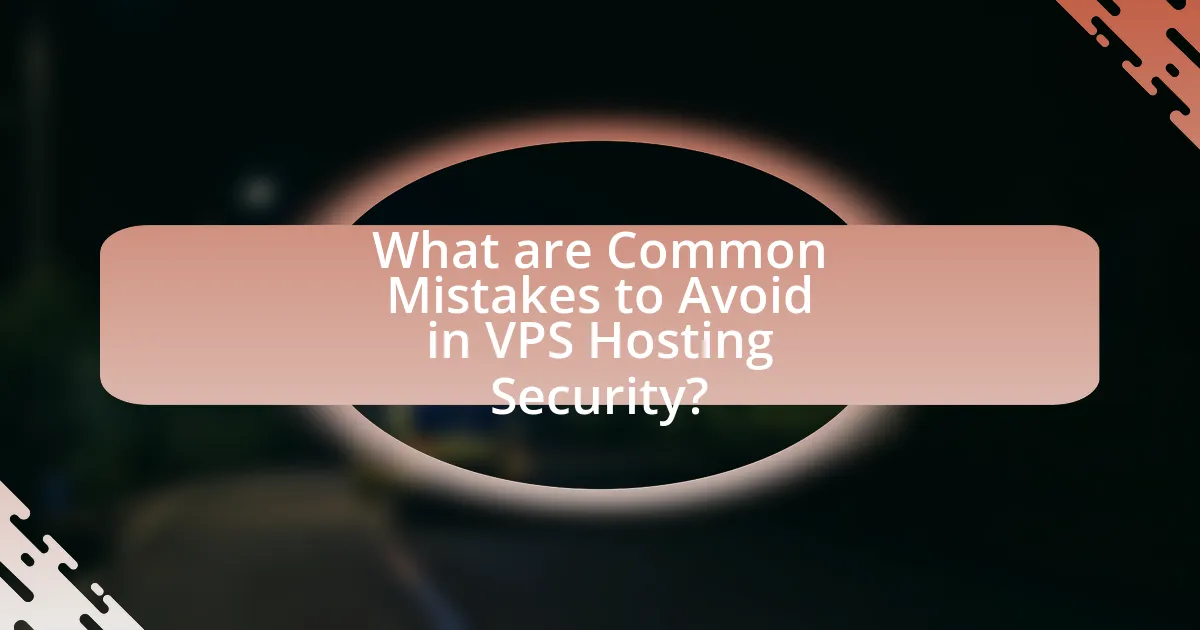
What are Common Mistakes to Avoid in VPS Hosting Security?
Common mistakes to avoid in VPS hosting security include neglecting regular software updates, failing to implement strong passwords, and not configuring firewalls properly. Regular software updates are crucial because outdated software can have vulnerabilities that hackers exploit; for instance, a study by the Ponemon Institute found that 60% of data breaches are linked to unpatched vulnerabilities. Strong passwords are essential as weak passwords can be easily guessed or cracked; the National Institute of Standards and Technology recommends using complex passwords that are at least 12 characters long. Additionally, improper firewall configuration can leave the VPS exposed to unauthorized access; according to a report by Cybersecurity Ventures, 70% of successful breaches involve a failure to configure firewalls correctly.
What are the pitfalls of neglecting software updates?
Neglecting software updates can lead to significant security vulnerabilities, increased risk of data breaches, and software incompatibility issues. When software is not updated, it remains exposed to known security flaws that hackers can exploit; for instance, according to a report by the Cybersecurity and Infrastructure Security Agency, 85% of successful cyberattacks leverage known vulnerabilities for which patches are available. Additionally, outdated software may not function properly with newer applications or systems, leading to operational inefficiencies. Furthermore, failure to update can result in non-compliance with industry regulations, which can incur legal penalties and damage to reputation.
How can outdated software lead to security vulnerabilities?
Outdated software can lead to security vulnerabilities because it often lacks the latest security patches and updates that protect against known threats. When software is not regularly updated, it becomes an easy target for cyber attackers who exploit these unpatched vulnerabilities. For instance, a study by the Ponemon Institute found that 60% of data breaches are linked to unpatched vulnerabilities, highlighting the critical need for timely software updates to mitigate risks.
What strategies can ensure timely updates and patches?
Implementing an automated update system is a key strategy to ensure timely updates and patches. Automated systems can regularly check for updates and apply them without manual intervention, significantly reducing the risk of vulnerabilities. For instance, many operating systems and software applications offer built-in features that allow for automatic updates, which can be configured to run during off-peak hours to minimize disruption. Additionally, maintaining a regular schedule for manual checks and updates can complement automation, ensuring that any critical patches released outside of the automated cycle are promptly addressed. According to a report by the Cybersecurity and Infrastructure Security Agency, timely patch management can reduce the risk of exploitation by up to 85%, highlighting the effectiveness of these strategies in enhancing security.
How does misconfiguration impact VPS security?
Misconfiguration significantly undermines VPS security by creating vulnerabilities that can be exploited by attackers. When settings are incorrectly applied, such as weak passwords, open ports, or improper access controls, it increases the risk of unauthorized access and data breaches. For instance, a study by the Ponemon Institute found that 60% of data breaches are attributed to misconfigured cloud settings, highlighting the critical nature of proper configuration in maintaining security. Additionally, misconfigured firewalls can allow malicious traffic, further compromising the integrity of the VPS environment.
What are the common misconfigurations in VPS setups?
Common misconfigurations in VPS setups include weak or default passwords, improper firewall settings, and outdated software. Weak passwords can be easily exploited, leading to unauthorized access; statistics show that 81% of data breaches are linked to weak passwords. Improper firewall configurations may leave unnecessary ports open, exposing the server to attacks, as 60% of breaches involve unpatched vulnerabilities. Additionally, running outdated software can lead to security vulnerabilities, with 70% of successful attacks targeting known exploits in outdated systems. These misconfigurations significantly increase the risk of security breaches in VPS environments.
How can users verify their VPS configurations for security?
Users can verify their VPS configurations for security by conducting regular security audits and using automated tools to assess vulnerabilities. Regular audits involve checking firewall settings, ensuring that only necessary ports are open, and reviewing user permissions to prevent unauthorized access. Automated tools like Nessus or OpenVAS can scan the VPS for known vulnerabilities and misconfigurations, providing detailed reports on security posture. Additionally, users should ensure that all software is up to date, as outdated software can be a significant security risk. According to a report by the Ponemon Institute, 60% of data breaches are linked to unpatched vulnerabilities, highlighting the importance of maintaining current software.
What are the best practices for monitoring VPS security?
The best practices for monitoring VPS security include implementing regular security audits, utilizing intrusion detection systems, and maintaining up-to-date software. Regular security audits help identify vulnerabilities and ensure compliance with security policies. Intrusion detection systems monitor network traffic for suspicious activity, providing real-time alerts for potential breaches. Keeping software updated is crucial, as outdated applications can be exploited by attackers; for instance, a report by the Cybersecurity and Infrastructure Security Agency (CISA) indicates that 60% of breaches are linked to unpatched vulnerabilities. These practices collectively enhance the security posture of a VPS environment.
How can users set up effective logging and monitoring?
Users can set up effective logging and monitoring by implementing centralized logging solutions and configuring alerts for critical events. Centralized logging solutions, such as ELK Stack (Elasticsearch, Logstash, Kibana) or Splunk, aggregate logs from various sources, making it easier to analyze and visualize data. Configuring alerts for critical events, such as unauthorized access attempts or system failures, ensures that users are promptly notified of potential security incidents. According to a 2021 report by the Ponemon Institute, organizations that effectively monitor their systems can reduce the average time to detect a breach by 12 days, highlighting the importance of proactive logging and monitoring practices.
What tools are available for real-time security monitoring of VPS?
Tools available for real-time security monitoring of VPS include Intrusion Detection Systems (IDS) like Snort and OSSEC, security information and event management (SIEM) solutions such as Splunk and LogRhythm, and firewall solutions like iptables and UFW. These tools provide continuous monitoring, alerting, and analysis of security events, enabling administrators to detect and respond to threats promptly. For instance, Snort can analyze network traffic in real-time to identify malicious activity, while Splunk aggregates and analyzes logs from various sources to provide insights into security incidents.
What practical tips can enhance VPS Hosting security?
To enhance VPS hosting security, implement strong password policies, regularly update software, and utilize firewalls. Strong passwords reduce the risk of unauthorized access; for instance, using complex combinations of letters, numbers, and symbols can significantly increase security. Regular software updates patch vulnerabilities, as evidenced by the fact that 60% of breaches exploit known vulnerabilities that could have been mitigated through updates. Firewalls act as a barrier between your VPS and potential threats, filtering incoming and outgoing traffic based on predetermined security rules. Additionally, employing two-factor authentication adds an extra layer of security, making it harder for attackers to gain access even if passwords are compromised.
